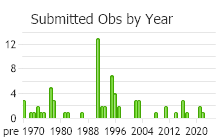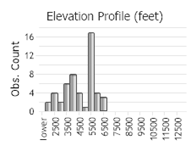View in other NatureServe Network Field Guides
NatureServe
Montana
Utah
Wyoming
Idaho
Wisconsin
British Columbia
South Carolina
Yukon
California
New York
A Timmia Moss - Timmia austriaca
Other Names:
Timmia austriaca var. brevifolia, Timmia austriaca var. papillosa
General Description
Plants: Acrocarpous. Growing in upright clumps, sometimes shiny, green or somewhat buttery-colored distally, reddish lower on the stem (Crum & Anderson et al. 1981), the upper leaves not falling. Stems 3-15 cm; possessing a central strand (FNA 2007); rhizoids numerous below (Smith 1980).
Leaves: Upright and overlapping or frequently spreading broadly and curved inward to nearly tubulose when dry, somewhat to strongly spreading (nearly 90 degrees) from the top of the base when wet (Crum & Anderson et al. 1981), the orange base enveloping the stem, and the green (nonsheathing) limb immediately lance-shaped (FNA 2007), somewhat pleated longitudinally (Lawton 1971); margins of limb boldly toothed above and smooth or weakly toothed below, or sometimes limb is completely either smooth or wavy (FNA 2007).
Leaf Cells: Limb laminal cells nearly square or slightly lengthened, 1-1.5:1 (Crum & Anderson et al. 1981), with smooth (FNA 2007) thick walls on the outer (dorsal) surface (Lawton 1971), and low mammillae on the inner (ventral) surface (FNA 2007); laminal cells of the sheath linear (Crum & Anderson et al. 1981), the upper ones smooth or bearing 1-8 frequently roughened, round papillae on the dorsal surface of the lumen; cells of leaf attachment not transparent; outer costal surface toothed or papillate distally, the inner surface mammillate, in X-section guide cells and stereid bands present (FNA 2007).
Diagnostic Characteristics
The transition from sheath to limb is the most precise one of the genus, with the angle between them sharp, and the color change from orange to green sudden. The orange sheath and sharp leaf angle (and dioicous condition, if present) distinguish this species from T. megapolitana. Its leaves are not deciduous whereas they are in T. norvegica (FNA 2007).
Range Comments
North American Range
AK to NL (not known in MB, ON, PE, or NS), s to CA, NV, NM, also SD and MI (FNA 2007). Known in Montana from Big Horn, Rosebud, and Sanders Counties (Elliott 2016).
Observations in Montana Natural Heritage Program Database
Number of Observations: 116
(Click on the following maps and charts to see full sized version)
Map Help and Descriptions
Relative Density

Recency



 (Observations spanning multiple months or years are excluded from time charts)
(Observations spanning multiple months or years are excluded from time charts)
Habitat
Wet stream banks (FNA 2007), soil in desert and steppe habitats (often forming extensive carpets) (Elliott 2016), soil on rock and in fissures of coniferous forests; montane (Crum & Anderson et al. 1981).
Reproductive Characteristics
Dioicous. Sporophytes irregular in occurrence over entire range, less common in Arctic habitats. Stem grows through and beyond the perigonia (FNA 2007). Seta 15-40 mm tall. Capsule ascending to level (Lawton 1971) or drooping (Crum & Anderson et al. 1981), frequently longitudinally pleated when dry, the theca 3-5 mm in length; the 64 long cilia of the endostome in groups of 4, knobby, papillate, lacking transverse ridges (Lawton 1971).
Stewardship Responsibility
References
- Literature Cited AboveLegend:
 View Online Publication
View Online Publication Crum, H.A. and L.E. Anderson. 1981. Mosses of Eastern North America. 2 volumes. Columbia University Press, New York. 1328 pp.
Crum, H.A. and L.E. Anderson. 1981. Mosses of Eastern North America. 2 volumes. Columbia University Press, New York. 1328 pp. Elliott, J.C. and A.K. Pipp. 2018. A Checklist of Montana Mosses (1880-2018). Updated 3 January, 2020. Montana Natural Heritage Program, Helena, Montana. 73 pp.
Elliott, J.C. and A.K. Pipp. 2018. A Checklist of Montana Mosses (1880-2018). Updated 3 January, 2020. Montana Natural Heritage Program, Helena, Montana. 73 pp. Flora of North America Editorial Committee, eds. 2007. Flora of North America North of Mexico. Volume 27. Bryophytes: Mosses, Part 1. Oxford University Press, Inc., NY. xxi + 713 pp.
Flora of North America Editorial Committee, eds. 2007. Flora of North America North of Mexico. Volume 27. Bryophytes: Mosses, Part 1. Oxford University Press, Inc., NY. xxi + 713 pp. Lawton, E. 1971. Moss Flora of the Pacific Northwest. Hattori Botanical Laboratory. Japan: Yamabuki-cho, Shinjuku-ku, Tokyo. 362 pages plus appendices.
Lawton, E. 1971. Moss Flora of the Pacific Northwest. Hattori Botanical Laboratory. Japan: Yamabuki-cho, Shinjuku-ku, Tokyo. 362 pages plus appendices. Smith, A.J.E. 1980. The Moss Flora of Britain and Ireland. Cambridge University Press, Cambridge. 705 pp.
Smith, A.J.E. 1980. The Moss Flora of Britain and Ireland. Cambridge University Press, Cambridge. 705 pp.
- Additional ReferencesLegend:
 View Online Publication
View Online Publication
Do you know of a citation we're missing? Elliot, J. C. 1993. Second checklist of Montana mosses. Unpublished report. U.S. Forest Service, Region 1. Missoula, MT. 45 pp.
Elliot, J. C. 1993. Second checklist of Montana mosses. Unpublished report. U.S. Forest Service, Region 1. Missoula, MT. 45 pp. Flowers, S. 1973. Mosses: Utah and the West. Brigham Young University, Provo, Utah. 567 p.
Flowers, S. 1973. Mosses: Utah and the West. Brigham Young University, Provo, Utah. 567 p. Lawton, E. 1971. Keys for the Identification of the Mosses on the Pacific Northwest. Reprinted from 'Moss Flora of the Pacific Northwest'. Published as Supplement No. 2 of the Journal of the Hattori Botanical Laboratory. Nichinan, Miyazaki, Japan. 66 pp.
Lawton, E. 1971. Keys for the Identification of the Mosses on the Pacific Northwest. Reprinted from 'Moss Flora of the Pacific Northwest'. Published as Supplement No. 2 of the Journal of the Hattori Botanical Laboratory. Nichinan, Miyazaki, Japan. 66 pp. Vitt, D. J. Marsh, and R. Bovey. 1988. Mosses, Lichens & Ferns of Northwest North America. Seattle, WA: University of Washington Press. 296 p.
Vitt, D. J. Marsh, and R. Bovey. 1988. Mosses, Lichens & Ferns of Northwest North America. Seattle, WA: University of Washington Press. 296 p.
- Web Search Engines for Articles on "A Timmia Moss"





